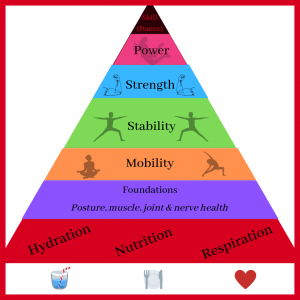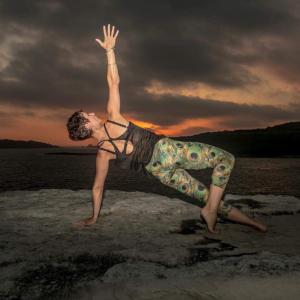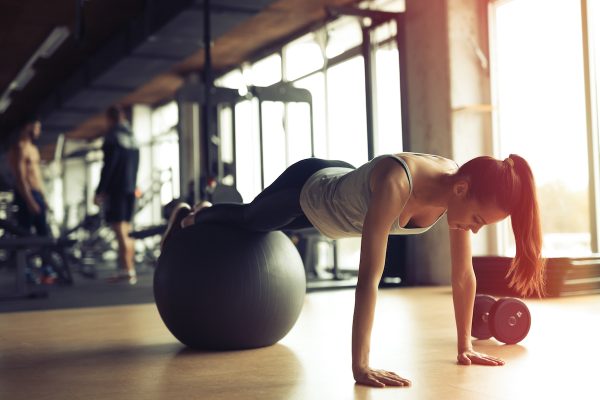The Pyramid of Performance
Stacking the Right Elements to be a Peak Performer
by Sally Harrison from Band-ITS & Strength4Dance
 We’ve heard the expression “practice makes perfect.” But have you ever found that no matter how hard you try, or how many times you repeat something, it just doesn’t seem to get better? Even worse ⏤ when fatigue (and frustration!) sets in, sometimes you find that the MORE you do something, the WORSE you get?
We’ve heard the expression “practice makes perfect.” But have you ever found that no matter how hard you try, or how many times you repeat something, it just doesn’t seem to get better? Even worse ⏤ when fatigue (and frustration!) sets in, sometimes you find that the MORE you do something, the WORSE you get?
If that sounds all too familiar ⏤ don’t worry. Here’s why it’s happening.
Dancing is a highly-skilled activity. With any skilled activity, when we think about what we need in order to perform at our best, it helps to apply a concept that is known as the ‘Pyramid of Performance.’
Right at the bottom of the pyramid are the three ‘-tions’ ⏤ Nutrition, Hydration, Respiration. This is the largest (and arguably the most important) part of the pyramid because it is the foundation upon which the rest is built. The three -‘tions’ encompass everything from our energy levels and cellular health, to our temperature control, and even our mood.
Next up is our Movement Foundations ⏤ our posture and ability to find centre. This includes the health of our muscles, joints and nerves. To maintain this level of the pyramid we need to think about our rest and recovery, as well as things such as massage, meditation and posture.
The next level in our performance pyramid is Mobility. NOT to be confused with how bendy our back is, mobility is actually about muscle balance and symmetry. Do we have optimal range of movement around the joints? Is there appropriate tension and tone in the muscles at rest? To address our mobility we think about things like yoga, and self release using tools such as foam rollers, spikey balls or cupping.
Then, we can progress to Stability. This is our ability to maintain optimal alignment against internal and external forces. Here, we’re thinking about core training for the hips, pelvis and shoulders. We’re making sure that the correct muscles are recruited at the correct time. Pilates, low-load high-rep exercise and exercise rehab classes can assist with our stability.
 After mastering stability we can think about the next level up ⏤ Strength! This is the development of movement patterns, focusing on our muscular control and adaptation to overload. Strength work can be loaded or unloaded but we ideally want to focus on varied and functional strength training using classes, gym or pilates.
After mastering stability we can think about the next level up ⏤ Strength! This is the development of movement patterns, focusing on our muscular control and adaptation to overload. Strength work can be loaded or unloaded but we ideally want to focus on varied and functional strength training using classes, gym or pilates.
Strength + Speed = POWER. This is where we progress the body to tricks such as jumps, leaps and kicks. We think about multi-directional movement as well as our acceleration and deceleration. We get the body used to this form of movement using cardio-vascular training and plyometric drills, as well as conditioning classes with external load.
Finally, right at the very top peak of the pyramid, is that tiny little point that represents Skill ⏤ in this case, Dancing.
Although it is important to practice our skill, if we just dedicate our whole time to this tiny little point, whilst neglecting the larger building blocks beneath, it will become very difficult to maintain or improve our dancing ability.
If we don’t have the power, strength, stability, mobility ⏤ or the foundations ⏤ which are represented further down the pyramid, our bodies won’t be well equipped to deal with the demands right at the top of the pyramid. In effect, it would all come collapsing down in the form of fatigue, injury, pain and general inability to keep up with the demands of your skill.
Chances are, if you’re really struggling with a particular move ⏤ that triple pirouette, high kick, flip or jump ⏤ instead of just practicing over and over again, you need to address something further down the pyramid. Maybe you need to work on your power for those jumps or your single leg balance for your turns. Maybe you just need a really good night’s sleep to give adequate energy to the routine that you’ve been working on.
There’s certainly a time and a place for practicing our routines, choreography and even our individual moves ⏤ but instead of stressing out and over-training at that point of the pyramid, try to assess what your body actually needs, by looking at the ‘Pyramid of Performance’, in order to help you get there.
Sally xx
Pro-Align physiotherapy for dancers
Read our recent articles on Functional Fitness for Dancers:












